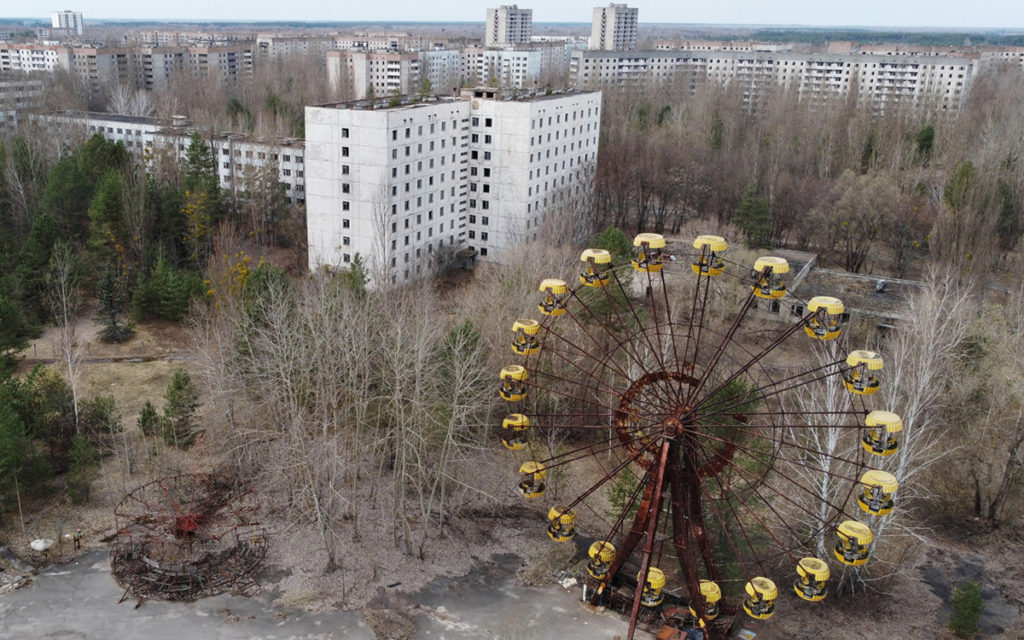
Chernobyl Fallout: Recovering the Lands of Belarus
Following the Chernobyl nuclear power plant accident, most of the radioactive emissions settled in the thirty-kilometre zone around the nuclear power plant itself. The population from this region were resettled, and the Polessky radiation-ecological reserve was created on the territory. About 70% of the radioactive fallout fell on the territory of Belarus, as a result of which the level of contamination of its territory is the highest of all countries affected by this tragedy. 20% of all forests in Belarus are still polluted, and 6,000 km2 of land have been withdrawn from agricultural use in accordance with legislation. 109,000 people were resettled. According to calculations made by the Institute of Economics of the National Academy of Sciences of Belarus, the total damage caused to the republic by the Chernobyl disaster, calculated for a 30-year period in overcoming it, is estimated at 235 billion US dollars, which is 32% of the republic’s budget in 1985. Irreparable damage was done to the Republic of Belarus, which had to experience the enormous socio-economic, political, environmental and medical consequences of the accident. A significant part of the damage is in the Mogilev region.
An area of 11.2 thousand square kilometres, covering 14 districts of the Mogilev region, was exposed to radioactive contamination. In such conditions, it is practically impossible for quick self-recovery of the affected territories, or the direct restoration of the facilities located on them. We can only talk about a long-term rehabilitation process, and only when it is safe for people and businesses to return to the sites of past radioactive contamination.
On the territory of radioactive contamination, depending on the density of soil contamination with radionuclides and (or) the average annual effective dose of irradiation of the population, the following zones of radioactive contamination have been set up:
1. zone of evacuation (exclusion) – the area around the Chernobyl nuclear power plant, from which the population was evacuated in 1986 (30-km zone and the territory from which additional resettlement of the population was carried out);
2. zone of priority resettlement;
3. zone of subsequent resettlement;
4. zone with the right to resettlement;
5. zone of residence with periodic radiation monitoring
Radioactive contamination of soil entails significant problems in agriculture, primarily associated with the acceptable quality of food products produced from them. Soils of natural ecosystems have also suffered significantly. The physicochemical state of radionuclides in the soil and, first of all, the number of their mobile forms are the determining factor in the processes of migration of radioactive substances in the soil profile and along the trophic chains.
Radioactive contamination is the ultimate technogenic load on the human environment, after which it loses its ecological attractiveness and becomes partially or completely unsuitable for the fully-fledged life of people. In such a situation, investment activity also practically ceases, primarily on commercial projects that imply a return on investment in the near future.
At the same time, the authorities are taking measures to restore these lands. So, in 2015, the experimentally south eastern region of the Mogilev region was singled out for as a priority area of economic development. This includes the lands of the Krichevsky, Klimovichsky, Krasnopolsky, Kostyukovichsky, Slavgorodsky, Cherikovsky and Khotimsky districts.
By the adopted regulations, it extends until 2025 the main provisions of the laws providing preferential terms for doing business and investing in these territories. This will create additional conditions for the integrated development of this region, improving the living standards of the population.
The state has determined the procedure for providing organisations with payments from the republican budget to reimburse up to 35% of capital costs that they will incur when implementing investment projects between 2021-2025. The list of these projects is determined by the government on the basis of proposals from the Mogilev Regional Executive Committee.
In the development of the real sector of the economy, the modernisation of cement plants should be noted. They were transferred to local types of fuel – peat briquettes. As a result, the share of local fuels in factories increased to 30 percent. The quality and volume of products remained the same, but the costs decreased.
The cement cluster in the Krichevsky region has been supplemented by a new plant for the production of cement-particle boards, which was opened by Belzarubezhstroy. Food – production of “Domochaya” corn sticks. With the participation of the Development Bank’s funds in the village of Peregon, Slavgorodsky District, the Mogilev Meat Processing Plant has built a pig-breeding complex for 24 thousand heads. To date, this is the largest project in the southeastern region. On the territory of the Slavgorod region, a production site for bottling honey was launched on the territory of the Krasny Pischevik – Slavgorod Unitary Enterprise. It is planned to process up to 300 tons of useful product here annually. And next year, the production of confectionery products will start operating in Slavgorod. Woodworking workshops were built in Klimovichsky, Kostyukovichsky, Krasnopolsky forestry enterprises, drying complexes – in Krasnopolsky and Cherikovsky. Also, the necessary equipment was purchased for the forestry enterprises. In the segment of small and medium-sized businesses, a number of industries were created, new jobs were organised.
These examples show the effectiveness of the chosen method of supporting the Chernobyl territories. The special legal status of the region makes it possible to organise profitable investments for potential investors. In view of the above, despite the negative consequences of the accident at the Chernobyl nuclear power plant, the affected regions have a fairly stable rate of development, which allows them to ensure the life of the population at a decent level.
Natalya Burlakova,
Expert of the Economics Department
of the Klichev District Executive Committee
